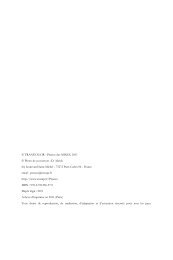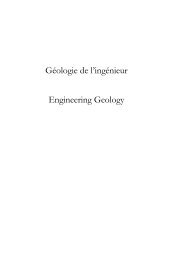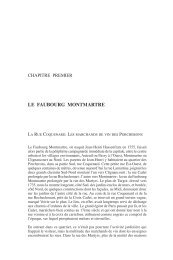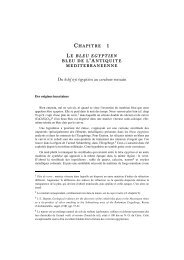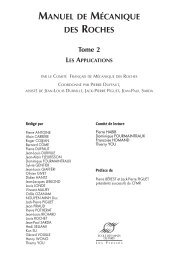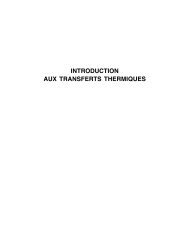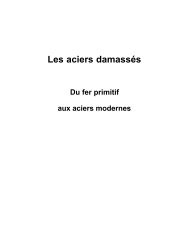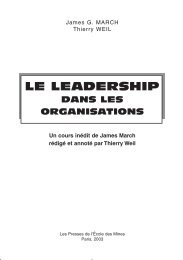Tribology of Manufacturing Processes - Presses des Mines
Tribology of Manufacturing Processes - Presses des Mines
Tribology of Manufacturing Processes - Presses des Mines
You also want an ePaper? Increase the reach of your titles
YUMPU automatically turns print PDFs into web optimized ePapers that Google loves.
4 th International Conference on <strong>Tribology</strong> in <strong>Manufacturing</strong> <strong>Processes</strong> - ICTMP 20103 WARM AND HOT FORGINGIn hot forging <strong>of</strong> C-steel, the workpiece is heated to 1000-1200˚C, but the die interfacetemperature has to be kept below 600˚C. This is achieved by spraying with lubricantcontaining a cooling medium or by using insulating films like glass and by keeping thecontact time with the workpiece low. Since oxi<strong>des</strong> themselves prevent seizure andreduce friction, many forging operations are done without lubrication. Low friction mayfurthermore not be <strong>des</strong>irable in hot forging, since this leads to increasing relative slidingbetween the workpiece and die which may cause increased wear, [38,39]. The role <strong>of</strong>the “lubricant” is then merely to ensure easy die release and saw dust has traditionallybeen used for this purpose. In complicated die forgings colloidal graphite dispersed inwater or oil has been applied by spraying.Efforts to find alternatives to graphite based lubricants have been driven by: a) Badworking environment, b) Earth leakage (electric conductivity <strong>of</strong> oil), c) Pipe corrosiondue to electric conductivity, Low recovery rate due to poor oil separation, [10].In 1983 a water soluble, carboxylic acid based high molecular weight, short chainedcompound was developed as a first substitute to graphite based lubricants, [40]. Thislubricant, which has good adherence to hot die surfaces at a temperature <strong>of</strong> 400˚C andgood lubricity were soon introduced in forging production <strong>of</strong> automotive parts andstarted the development <strong>of</strong> non-graphite based lubricants for warm and hot forging, [41].From around 1985 a number <strong>of</strong> alternatives to the graphite based lubricants wereactively promoted in industry.Nakamura [42] gives a comprehensive overview <strong>of</strong> the lubricants applied for warm andhot forming <strong>of</strong> C-steels, high alloyed steels, Ni-alloys and Al-alloys. The lubricantsinclude calcium stearate, water soluble high-molecular weight polymer, high-molecularweight carboxylate, water soluble glass, super high-molecular weight polyethylene, BN+ glass + graphite, graphite + B 2 O 3 , graphite + resin, etc. Kawabe [43] reports results <strong>of</strong>a Japanese industry survey in 1993 disclosing that 21% <strong>of</strong> the companies had totallyabandoned graphite based lubricants and were exclusively using white lubricants, butdie life was considerably lowered. Less than 10 years later, in 2001 white lubricantswere narrowed down to the following [9,30]: 1) Polymer base, 2) Carvone base, 3)Liquid glass base.Hibi [44] gives a good overview <strong>of</strong> possible water soluble high-molecular weightpolymers for warm and hot forging. The main element in the polymer base is alkylmaleate. The carvone base oils are essential oils such as volatile or ethereal oils fromplants. The main content <strong>of</strong> these lubricants are carboxylic acids such as fumaric acidand isophtalic acid. The liquid glass base lubricants are Si-glass containing colloidalsilica. Figure 7 shows the range <strong>of</strong> applicability <strong>of</strong> these white lubricants with a number<strong>of</strong> industrial component examples. Today Toyota has completely replaced blacklubricants in warm and hot forging with white ones, which are claimed to have excellentoil separation properties and high recovery rate, reducing the amount <strong>of</strong> waste liquid perforging line to less than 10% <strong>of</strong> that <strong>of</strong> graphite based lubricants. They imply, however,drawbacks such as lower lubricity and more difficult die release. This eventually reducesdie life if no special precautions are made such as considering the film thickness andspraying conditions to optimize die cooling.12



